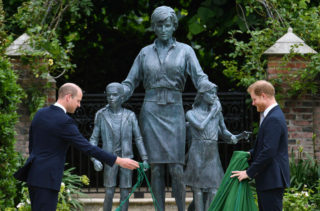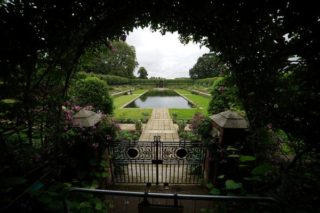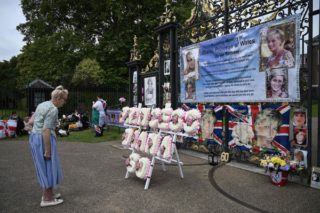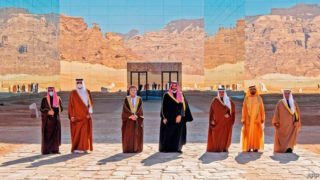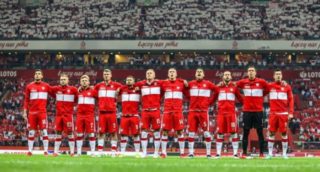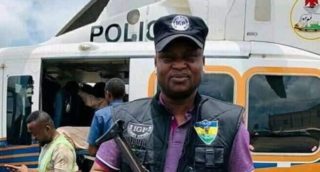LONDON — Bonded by childhood grief, sundered by adult quarrels, Prince William and Prince Harry came together briefly on Thursday to dedicate a statue of their mother, Diana, Princess of Wales, on what would have been her 60th birthday.
For a few fleeting minutes in the Sunken Garden at Kensington Palace, the two brothers set aside a season of acrimony — the anguished charges, and angry denials, of racism and callous treatment — to pay tribute to a woman whose sudden death 24 years ago ended her own turbulent history in the royal family.
Gently pulling two green cords, they unveiled a bronze statue that depicted Diana with children gathered in her outstretched arms. The memorial, they said, was meant to honor “her love, strength and character.”
“Every day, we wish she were still with us,” the brothers said in a rare joint statement.
But this was no cathartic reconciliation: William and Harry, by all accounts, are still barely on speaking terms.
The elder brother, William, royal watchers say, is still deeply aggrieved at his younger brother, Harry, for a series of interviews in which he and his wife, Meghan, described royal life as a kind of gilded prison and said family members held retrograde views on mental health and racial issues.
“It’s going to take a lot for this rift to be healed,” said Penny Junor, the author of several books about the royal family. “The initiative has to come from Harry, and it doesn’t seem to me that he is in any mood to do so.”
While the brothers labored to present a united front — smiling occasionally — they kept a palpable distance from each other as they gazed at the statue. A handful of Diana’s family members watched from across the redesigned garden, planted with a riot of forget-me-nots, sweet peas, tulips, roses and other flowers that she loved.
The Sunken Garden, below the apartment where she lived, was a refuge for Diana, according to officials at Buckingham Palace. She often played there with William and Harry, who later had their own quarters in Kensington Palace, before Harry abruptly announced in 2020 that he and Meghan, a biracial American former actress, would withdraw from official duties and move away from Britain.

The Sunken Garden was a refuge for Diana, according to officials at Buckingham Palace. Aaron Chown/Press Association, via Associated Press
The couple settled in Montecito, Calif., where Meghan recently gave birth to their second child, Lilibet Diana, whose name pays tribute both to Harry’s mother and to his grandmother, Queen Elizabeth II (her childhood nickname was Lilibet). Meghan did not fly to London for the unveiling, and Harry was not scheduled to stay around long after the 30-minute ceremony.
Harry and William were last reunited in April at the funeral of the queen’s husband, Prince Philip, walking behind their grandfather’s coffin much as they had walked together as young boys behind their mother’s funeral cortege. This time, one of their cousins walked conspicuously between them.
As William and Harry departed the service in St. George’s Chapel at Windsor Castle, the British press scrutinized their body language for evidence that they had broken the ice. Aside from a few cursory words and glances, there were few signs of a thaw, and Harry quickly flew back to California.
The brothers managed to stay on the same page in excoriating the BBC last month after it published the results of an internal investigation into a sensational 1995 interview given by Diana to the journalist, Martin Bashir. It concluded that Mr. Bashir had used deceitful means to obtain the interview, in which Diana spoke about the adultery that destroyed her marriage to Prince Charles.
William accused the BBC of making “lurid and false claims about the royal family, which played on her fears and fueled paranoia.” Harry, referring to a “culture of exploitation and unethical practices” by the news media, said, “our mother lost her life because of this, and nothing has changed.”
Even then, though, their statements spoke to their lives apart and different worldviews. While William condemned what he called “fake news,” he reaffirmed the importance of a free press and public service broadcasting. Harry put the interview in the context of a systemically broken press and drew a direct link from it to his mother’s death in a car crash in Paris in 1997.

Britons paid their respects on Thursday outside Kensington Palace, where Diana once lived. Daniel Leal-Olivas/Agence France-Presse — Getty Images
Days earlier, Harry said on a podcast that he thought the First Amendment of the United States Constitution, which protects a free press, was “bonkers.” He added that he did not know much about it, given his recent arrival in the country. Some royal watchers interpreted William’s statement as a subtle dig at Harry for his much-criticized comments.
The rift between the brothers, which opened around the time Harry and Meghan were married, deepened after the couple’s interview with Oprah Winfrey in March. They claimed that before the birth of their first child, Archie, a member or members of the family had expressed anxiety about the skin color of Meghan’s unborn baby.
“We’re very much not a racist family,” William said, when asked about his brother’s allegations.
The social distancing restrictions imposed by the pandemic kept the ceremony exclusive and private, which royal watchers said was a blessing because it reduced scrutiny of William and Harry. Neither the queen, Charles nor William’s wife, Kate, took part. But Diana’s brother, Charles Spencer, and her two sisters, Sarah McCorquodale and Jane Fellowes, were on hand.
A small crowd gathered near Kensington Palace, some with balloons and posters wishing Diana a happy 60th birthday. But the ceremony was hidden behind a tall hedge. The garden will be open to the public starting Friday.
The statue was designed by the sculptor Ian Rank-Broadley, whose likeness of the queen has been stamped on coins in Britain since 1998. The Sunken Garden, conceived by King Edward VII in 1908, was remodeled for the occasion by Pip Morrison, a landscape architect who specializes in historic gardens.
In a statement, Mr. Morrison said he aimed to create “a calming place for people to visit Kensington Palace to remember the princess.”
FEATURED IMAGE: Prince William and Prince Harry unveiled a statue of their mother, Diana, Princess of Wales, at Kensington Palace in London on what would have been her 60th birthday. Pool photo by Dominic Lipinski
By Mark Landler/The New York Times

